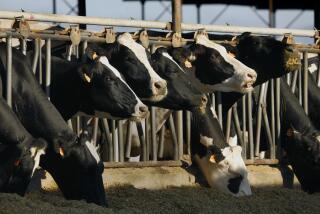Little Data Exists on Extent of Toxin in Midwest Corn
- Share via
CHICAGO — Although a month has passed since a cancer-causing toxin was first found in drought-damaged corn throughout the Midwest, little is known about the extent of the contamination of the grain widely used in human food, as well as in beef, pork and poultry feed.
Of the nation’s three major corn producing states, only Illinois has tested a broad sample of grain for the presence of aflatoxin, a poison produced by a fungus found in topsoil.
The Food and Drug Administration has published guidelines on the use of contaminated corn, but it has not made an effort to quantify the problem.
And, although state agriculture directors are conferring regularly, no central clearing house has been established to collect or evaluate the scattered data being gathered by individual states and by agricultural schools throughout the Midwest.
“We feel it isn’t a significant problem, but we have to be careful,” said Dale M. Cochran, Iowa’s secretary of agriculture.
“We know it’s there; we know it’s fairly widespread in the Corn Belt,” said Charles Hurburgh, a professor of agricultural engineering at Iowa State University. “And a lot of states are trying to get a handle on it.”
A carcinogen associated with liver cancer, aflatoxin has been found this year in six Midwestern states--where it rarely occurs--and in in Texas, Oklahoma and Maryland. The toxin is generally found in areas where grain has been damaged by heat and drought. In addition to corn, peanuts and cotton are vulnerable to aflatoxin.
“I think it is a major threat, a problem nobody knows the exact dimensions of,” said Rodney E. Leonard, executive director of the Washington-based Community Nutrition Institute, a public interest group that focuses on food policy issues.
“The FDA has a responsibility to make certain contaminants do not enter the food supply, and they have chosen to ignore the problem by reducing the standards,” Leonard charged.
This week the FDA issued guidelines permitting wider use of contaminated corn in animal feed but holding the line on 20 parts per billion for grain destined for human consumption and for dairy cows. Milk can contain only one-half part per billion.
The new guidelines permit interstate shipment of corn tainted with up to 100 parts per billion of aflatoxin if state officials can guarantee that corn will be used only to feed mature beef cattle, hogs and poultry. The FDA is also permitting hogs being prepared for slaughter to be fed grain with up to 200 parts per billion and cattle headed for slaughter with corn containing up to 300 parts per billion. Previously the maximum allowed in animal feed was 100 parts per billion.
“There hasn’t been any relaxation of regulations,” said Catherine W. Carnevale, associate director of the FDA’s contaminants policy staff, adding that levels of aflatoxin contained in FDA guidelines are based on “what toxicologists say they can support . . . in court.”
Increased Testing
Despite the FDA’s position, food companies that use corn are reportedly increasing their own testing. Cargill, one of the biggest grain companies operating in the Midwest, is rejecting corn with aflatoxin levels above 20 parts per billion, a company spokesman said.
“Our overwhelming priority, from the onset, has been in terms of the food supply, and that that was something that should not be compromised,” said Mark Randal, spokesman for the Illinois Agriculture Department. “Grain is an incredibly hard thing to keep track of. It goes in great piles and into great bins, and there is a large amount of responsibility (for assuring safety) that still rests with the industry.”
“If you were going to feed everything to dairy cows or put it in cornflakes, you’d have a problem,” said Iowa’s Cochran. “But we have other outlets for the grain. I think we can work the problem out pretty well.”
The most comprehensive testing so far has been done by the Illinois Department of Agriculture. Those tests suggest that in Illinois at least, where some of the most severe drought damage can be found, the problem may be serious.
Of 327 randomly selected samples of corn from throughout Illinois, 35.8% contained aflatoxin levels above 20 parts per billion. In neighboring Indiana, where a much smaller sample of corn was tested, only 9% showed levels of the toxin above the FDA minimums. Testing is not yet completed in Iowa, where the harvest is more than half completed and where the drought has cut the corn crop by 40%. Together these three state generally account for about 45% of the nation’s corn supply.
More to Read
Sign up for Essential California
The most important California stories and recommendations in your inbox every morning.
You may occasionally receive promotional content from the Los Angeles Times.













